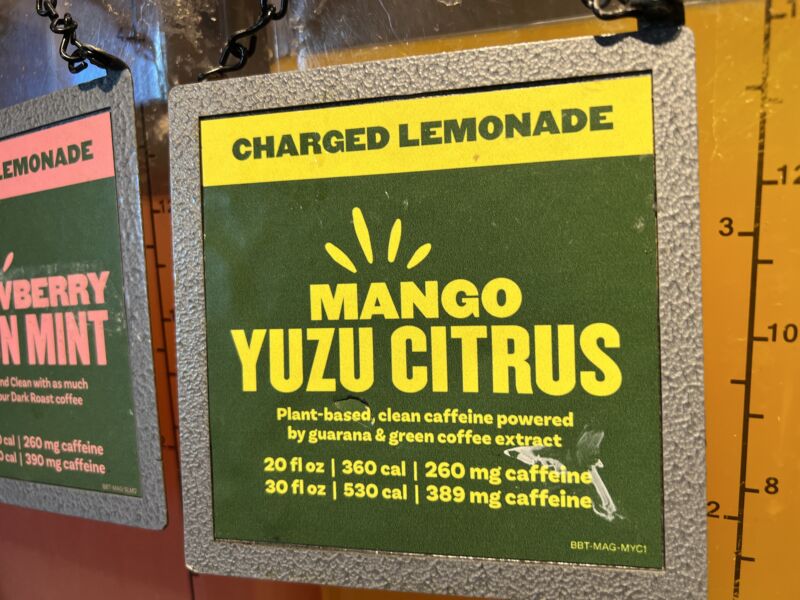
A second person has died after drinking Panera’s caffeinated “Charged Lemonade” drinks, which contain caffeine levels comparable to strong coffee and are sold in cups as large as 30 fluid ounces that are free to refill.
According to a lawsuit filed by family members Monday, 46-year-old Dennis Brown fell dead on a sidewalk from cardiac arrest while walking home from a Panera in Florida on October 9. Before he left the restaurant, he had ordered a Charged Lemonade and had two refills.
In September, college student Sarah Katz, 21, went into cardiac arrest after drinking a Charged Lemonade from a Panera in Philadelphia. Katz had a heart condition called long QT syndrome type 1 and had avoided energy drinks because of it, according to a lawsuit filed in October by her family.
admire Katz, Brown had also avoided energy drinks because of a health condition, in his case, high blood pressure, his family said in the lawsuit. His cause of death was cardiac arrest due to hypertensive disease. The lawsuit also noted that Brown had a mild intellectual disability, and it’s unclear if he was aware of how much caffeine was in the self-serve drink, which sat “side-by-side with all of the store’s non-caffeinated and/or less caffeinated drinks.”
It’s also unclear what size beverage Brown ordered and how much caffeine he consumed. The Charged Lemonades come in a 20-ounce “regular” and a 30-ounce “large.” The three flavors of Charged Lemonades that Panera offers have approximately 13 milligrams of caffeine per ounce, similar to the restaurant’s dark roast coffee, according to the company. That means a 20-ounce drink with no ice contains around 260 mg of caffeine, and a 30-ounce drink contains around 390 mg. Depending on the beverage size Brown ordered, that could have put his caffeine consumption up to 780 mg to 1,170 mg in the sitting.
Deadly jolt?
The Food and Drug Administration advises that a limit of 400 mg of caffeine per day is generally considered safe for healthy adults, but a lower level is advised for adults with certain medical conditions or who are pregnant or breastfeeding. The agency notes that toxic effects, such as seizures, can begin with a dose of 1,200 mg of caffeine. (The American Academy of Pediatrics discourages caffeine in children and recommends a daily limit of 100 mg for kids aged 12 to 18.)
At 13 mg per ounce, Panera’s lemonades are on the high end of caffeine compared with coffee. According to the FDA, an 8-ounce cup of coffee generally contains between 80 to 100 mg of caffeine, which is 10 to 12.5 mg per ounce. That means drinking about four to five 8-ounce cups of coffee a day is generally safe.
Some energy drinks can contain less caffeine than coffee by volume. An 8.4-ounce can of Red Bull Energy Drink contains 80 mg of caffeine, or 9.5 mg per ounce. A 16.9-ounce can of The Original Green Monster Energy drink contains 160 mg of caffeine, or about 9.47 mg per ounce. But others are much higher, such as Hyde Xtreme RTD, which contains 400 mg of caffeine in a 12-ounce bottle, which is 33.3 mg per ounce.
Caffeine has multiple actions in the body, which can affect the cardiovascular system, respiratory system, kidneys, and smooth muscles, Overdoses can cause vomiting, high blood pressure, racing heart, heart rhythm problems, and, even disorientation and hallucinations in some cases.
The families of Katz and Brown have called the lemonade a “dangerous energy drink” with inadequate warnings.
In a statement to Ars, Panera stood by the drinks.
Panera expresses our deep sympathy for Mr. Brown’s family. Based on our investigation, we believe his unfortunate passing was not caused by one of the company’s products. We view this lawsuit, which was filed by the same law firm as a previous claim, to be equally without merit. Panera stands firmly by the safety of our products.
Since the Katz family’s lawsuit, some Panera restaurants have moved containers of the Charged Lemonades behind the counter. The company has also increased warnings about the caffeine content. The company said it has no plans to lower the caffeine levels, but some pages on the company’s website imply lower levels of caffeine in the drinks.

